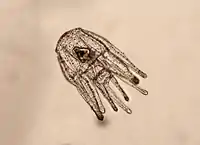Echinobase
Echinobase is a web information system that catalogs diverse genomic and biological data for the echinoderm clade. The system provides a gene search engine, genomics browser and other bioinformatics tools to explore genomic and transcriptomic data. The Echinobase information system focuses on information from eight echinoderm research models: Strongylocentrotus purpuratus, Strongylocentrotus fransciscanus, Allocentrotus fragilis, Lytechinus variegatus, Patiria miniata, Parastichopus parvimensis and Ophiothrix spiculata, Eucidaris tribuloides. The goal of Echinobase is to support molecular biological science including developmental processes and gene regulatory networks.[1]
 | |
|---|---|
| Content | |
| Description | A sea urchin |
| Organisms | Echinoderms |
| Contact | |
| Research center | http://beckmaninstitute.caltech.edu/crg.shtml |
| Access | |
| Website | http://www.echinobase.org/ |
Software, hardware and platform
Echinobase provides a comparative genomics platform for the echinoderm clade which includes genomes and transcriptomes for Strongylocentrotus purpuratus, Lytechinus variegatus, Patiria miniata, Parastichopus parvamensis and Ophiothrix spiculata. Echinobase was created with software Maker 2, GLEAN, SNAP gene, AUGUSTUS, Web Apollo tool, RepeatModeler pipeline, genbank , IPR scan, NCBI, BLAST, PubMed. Echinobase works in a cloud environment that employs Drupal, PHP, CSS, JavaScript and PostgreSQL.
Tools and content
- About echinoderms by species (trongylocentrotus purpuratus, Patiria miniata, Lytechinus variegatus, Allocentrotus fragilis, Eucidaris tribuloides, Parastichopus parvimensis, Ophiothrix spiculata, Strongylocentrotus franciscanus).
- Jbrowse
- BLAST
- Tools: ATAC-seq browser, Gene search, Bac Table, Image library, Transcriptome search
- S purp Gene Search
- Gene Nomenclature Guidelines
- Materials and Methods
- Resources (filters, bacs, SU codon usage table, QPCR primers, Nanostring Codeset.
- Literature search: Textpresso for Echinoidea
Publications and research utilizing Echinobase
- Extracellular matrix remodeling and matrix metalloproteinases (ajMMP-2 like and ajMMP-16 like) characterization during intestine regeneration of sea cucumber Apostichopus japonicus.[2]
- Short tandem repeats, segmental duplications, gene deletion, and genomic instability in a rapidly diversified immune gene family.[3]
- Analysis of cytokinesis by electron microscopy.
- An anterior signaling center patterns and sizes the anterior neuroectoderm of the sea urchin embryo.[4]
- Echinoderm development and evolution in the post-genomic era.[5]
- SpBase: the sea urchin database and website[6]
- The Genome of the Sea Urchin Strongylocentrotus purpuratus[7] (The Sea Urchin Sequencing Consortium. Science.)
References
- Kudtarkar, Parul; Cameron, R. Andrew (2017-01-01). "Echinobase: an expanding resource for echinoderm genomic information". Database. 2017. doi:10.1093/database/bax074. PMC 5737241. PMID 29220460.
- Miao, Ting; Wan, Zixuan; Sun, Lina; Li, Xiaoni; Xing, Lili; Bai, Yucen; Wang, Fang; Yang, Hongsheng (October 2017). "Extracellular matrix remodeling and matrix metalloproteinases (ajMMP-2 like and ajMMP-16 like) characterization during intestine regeneration of sea cucumber Apostichopus japonicus". Comparative Biochemistry and Physiology. Part B, Biochemistry & Molecular Biology. 212: 12–23. doi:10.1016/j.cbpb.2017.06.011. ISSN 1879-1107. PMID 28687360.
- Oren, Matan; Barela Hudgell, Megan A.; D’Allura, Brian; Agronin, Jacob; Gross, Alexandra; Podini, Daniele; Smith, L. Courtney (2016-11-09). "Short tandem repeats, segmental duplications, gene deletion, and genomic instability in a rapidly diversified immune gene family". BMC Genomics. 17 (1): 900. doi:10.1186/s12864-016-3241-x. ISSN 1471-2164. PMC 5103432. PMID 27829352.
- Range, Ryan C.; Wei, Zheng (2016-05-01). "An anterior signaling center patterns and sizes the anterior neuroectoderm of the sea urchin embryo". Development. 143 (9): 1523–1533. doi:10.1242/dev.128165. ISSN 1477-9129. PMC 4909856. PMID 26952978.
- Cary, Gregory A.; Hinman, Veronica F. (2017-07-15). "Echinoderm development and evolution in the post-genomic era". Developmental Biology. 427 (2): 203–211. doi:10.1016/j.ydbio.2017.02.003. ISSN 1095-564X. PMID 28185788.
- Cameron, R. Andrew; Samanta, Manoj; Yuan, Autumn; He, Dong; Davidson, Eric (January 2009). "SpBase: the sea urchin genome database and web site". Nucleic Acids Research. 37 (Database issue): D750–D754. doi:10.1093/nar/gkn887. ISSN 0305-1048. PMC 2686435. PMID 19010966.
- Sea Urchin Genome Sequencing Consortium; Sodergren, E; Weinstock, G. M; Davidson, E. H; Cameron, R. A; Gibbs, R. A; Angerer, R. C; Angerer, L. M; Arnone, M. I; Burgess, D. R; Burke, R. D; Coffman, J. A; Dean, M; Elphick, M. R; Ettensohn, C. A; Foltz, K. R; Hamdoun, A; Hynes, R. O; Klein, W. H; Marzluff, W; McClay, D. R; Morris, R. L; Mushegian, A; Rast, J. P; Smith, L. C; Thorndyke, M. C; Vacquier, V. D; Wessel, G. M; Wray, G; et al. (2006-11-10). "The Genome of the Sea Urchin Strongylocentrotus purpuratus". Science. 314 (5801): 941–952. Bibcode:2006Sci...314..941S. doi:10.1126/science.1133609. ISSN 0036-8075. PMC 3159423. PMID 17095691.